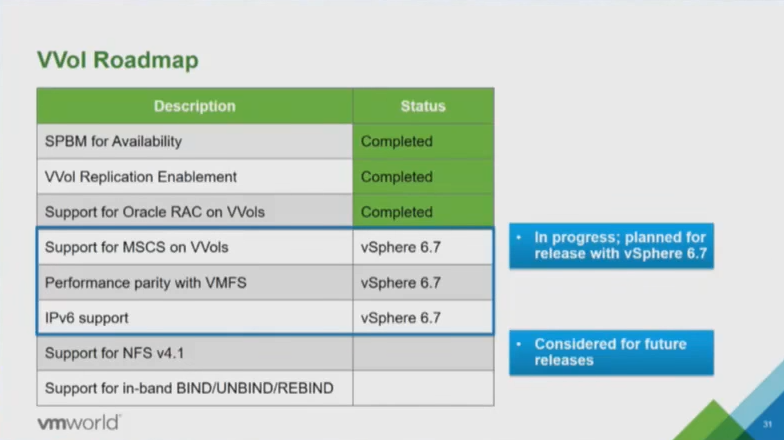I’ve known the VVols roadmap for quite a while but haven’t been able to share that publicly but VMware recently just shared it in a VMworld VVols session that is publicly available on YouTube so I though I would comment on that. If you watch the STO2446BU – VMware Virtual Volumes Technical Deep Dive replay you can find this slide near the end of that session (53:11).
 So the VVols roadmap for the next release of vSphere contains the following:
So the VVols roadmap for the next release of vSphere contains the following:
- Support for Microsoft Cluster Server (MSCS) – This was one of the reasons people still use RDMs and is one use case not supported by VVols today. This will help remove another barrier to VVols adoption.
- Performance parity with VMFS – So this one is a bit misleading as VM workload performance is not really any better or worse with VVols just like the whole VMFS vs. RDM performance argument that used to exist. The I/O data paths and multi-pathing between a host and VVols isn’t really any different with VVols with the exception of the path going through a Protocol Endpoint to get to the VVols. I think what VMware means by performance parity is more just optimizing some of the VVol specific operations like the bind process, VASA connections and how VVols handles metadata to be more efficient. Overall though some aspects of VVols are faster than VMFS such as the whole snapshot mechanism.
- IPv6 support – vSphere already supports IPv6, this one is specifically for supporting IPv6 on the VASA Provider service.
The other things you see there like NFS v4.1 support and in-band bind are being considered for other vSphere releases beyond the next vSphere release. In-band bind has been one that VMware has been trying to do for a while now, today the bind operation happens out-of-band using the control path through the VASA Provider and the goal is to bring it in-band to the data path through the Protocol Endpoint instead. This should improve the efficiency of the bind operation and eliminate a potential failure point. You can read more about this on a post I did about a year ago.
[notice]Note while you see vSphere 6.7 mentioned in the slide above, that has not been officially announced or confirmed as the version for the next vSphere release.[/notice]



